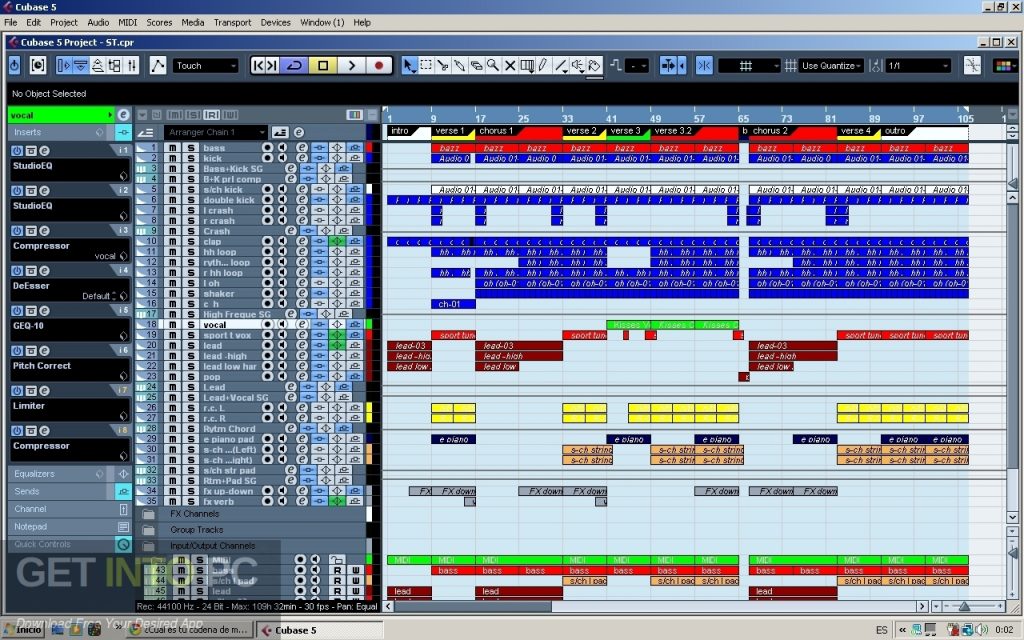
The obvious targets are Cutoff, Resonance, Drive and Mix. (This process was covered in the Cubase workshop in SOS July 2009, so I'll not retread that ground here.) Once you've done this, specific Tonic controls can be linked to a QC slot via the Inspector. Link your chosen controller(s) to Cubase's Quick Controls via Devices / Device Setup / Quick Controls. If all you want is a simple filter sweep in sync with your song, it needn't get any more complicated, but Tonic offers plenty more variety.įor our second example, a more hands‑on approach, with a hardware MIDI controller, is required. The Mix level, which adjusts the blend of unprocessed and filtered sounds, and the Depth knob, which controls how extreme the filtering gets, now become your two main ways of controlling the effect. The 16-step, sine‑wave-shaped LFO pattern produces a gradual change in the filter, while the high Smooth control smooths out transitions between steps of the LFO pattern.

#CUBASE 5 FULL MOD#
With all the Env Mod controls set to minimum or neutral, this section is effectively bypassed, and the filter, which I've set to Band Pass (BP), simply sweeps at a speed set by the Rate control (two steps per beat here) in the LFO Mod section. For our first example, a simple filter sweep that's automatically sync'ed to the project tempo, all we need to add is our filter plug‑in (in this case Tonic, pictured left). With our VST Instrument configured, we can build our processing chain. Quick Controls on the Instrument Track give you easy access to key parameters of your audio plug‑ins, as illustrated here for Tonic. You should now have a track that combines the recording/playback of MIDI data with an audio output for your Instrument, the ability to place audio Insert effects on its output, and access to Quick Controls in the Inspector. To create your Instrument track, go to Project / Add Track / Instrument, and select your choice of Instrument in the dialogue box that appears. (Unfortunately, they allow only a single stereo output, so you can't take different outputs from a multi‑output instrument such as Kontakt when working in this way.) Meanwhile, a better option is to use dedicated Instrument Tracks, as these do support Quick Controls. I'm told that this may be addressed in the forthcoming Cubase 5.5 update, which has just been announced. At the time of writing, this approach has an important limitation: like Group Channels and FX Channels, VST Instrument audio channels set up in this way do not support the very useful Quick Controls, which I explored back in SOS July 2009. So you could take the traditional approach to create your instrument - which is to add it directly to the VST Instruments panel, create a suitable MIDI channel and assign its output to the VST Instrument, and then insert Tonic on the audio output channel of the Instrument in the Inspector (or the Mixer). As with any insert plug‑in effect, Tonic needs to be placed across the audio output channel of your VST instrument. I'm going to use a VST synth as my sound source, because this is one of the most common sources to which such effects will be applied.Ĭubase includes a number of filter effect plug‑ins, but Tonic is the most flexible and interesting.

The principles of what follows can be applied to any audio track, whether an individual instrument, a group channel or a complete mix. First Stepsįor a basic filter sweep in Tonic, keep things simple: set the Env controls to neutral. If you'd like to hear some short audio clips to help you understand the effects and sounds I'm describing, you can find them at /sos/may10/articles/cubasetechaudio.htm.
#CUBASE 5 FULL MANUAL#
The first example involves basic filter‑sweep processing that's sync'ed to the project tempo the second requires filter sweeping under manual control - which allows you to use automation and a MIDI controller to alter the effect in real time and the third uses a gate to give the filter processing a stronger rhythmic component. To illustrate the mechanics involved, let's consider some examples: a combination of three ought to do the trick. Whether it's Donna Summer's 'I Feel Love', Modjo's 'Lady', Shapeshifters' 'Lola's Theme', Madonna's 'Future Lovers', or any number of dance classics, filter sweeps abound - and Cubase 5 features a number of tools that can, in combination, make configuring and controlling such effects very easy. Using an Instrument Track to host your VST Instrument (as shown here in green for the Embracer synth) gives you access both to audio insert effects and to the Quick Control system.


 0 kommentar(er)
0 kommentar(er)
